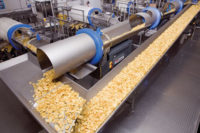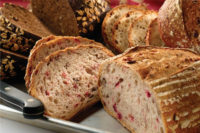Getting ahead with robotics
















New developments in robotics and automation are saving bakers and snack food manufacturers more in labor-related costs and enhancing their production efficiencies.
When it comes to producing baked goods and snacks, taking any labor out of the equation not only cuts costs, but also can increase operating efficiencies. New innovations in robotics and automation geared for food production are accomplishing just that. As a result, such equipment has been gaining acceptance by the bakery and snack industry in recent years.
“Careful analysis of each application is required to make sure that robotic automation is the best answer,” says Charles C. Gales, manager of automation sales at Weldon Solutions, York, Pa. “Traditional [stationary or fixed] automation (meaning machine motion must follow a certain fixed path between two points) may work very well in situations where there’s little variation in product size and package configurations or where few production line changeovers are required.”
Because these environments tend to include wet and/or sticky ingredients, much of the technology centers on material handling and packaging.
“Robots bring considerably more flexibility to an application, but ‘hard’ automation systems are still being utilized, generally for cost reasons,” says Rick Hoskins, director of sales and marketing at Colborne Foodbotics, Lake Forest, Ill. “A major stumbling block in the [equipment] evaluation process is the lack of qualified robot specialists, and the misplaced perception that [an expert] is needed onsite to handle problems. Based on our [experience], that’s just not accurate.”
Colborne Foodbotics has unveiled a number of automation advancements, including an expanded version of its BBL line of basket/case-loading systems, which include multiple levels of automation and custom features.
“We have also developed a full line of basket-handling equipment that includes unstackers and stackers with or without auto dolly handling; capacity enhancer technology to boost feed rates to 40-plus baskets per minute per lane; multi-test individual basket inspection and auto rejection of bad baskets; auto trash dumping; and complex multi-level conveyor systems that can be easily matched to any plant condition,” Hoskins explains.
The company’s robotic depanner system also has been enhanced to pick and pack virtually any pattern, including picking from a rectangular pan and placing a round pattern. “These systems are very stable at high throughput levels with negligible cripples, are equipped with automatic tool changeover and exceed Baking Industry Sanitation Standard Committee (BISSC) sanitary standards,” Hoskins says.
In terms of new technology, Intelligrated, a Mason, Ohio-based company that provides automated material-handling systems in the logistics industry, has been focusing on automation in case packing and palletizing. “Our organization focuses on optimizing supply-chain challenges and, as it relates to snack food and bakery applications, we’re on the end-of-the-line packaging and logistics side,” says Matt Wicks, the company’s vice president of software and controls. “This includes case packing, palletizing and sortation conveyance.”
Robots are self-monitoring, so when something goes wrong, they analyze the error and provide immediate information on where to find the fault and correct the problem. In almost all instances, it is a minor issue—such as a sensor that got bumped and needed adjustment—that is corrected immediately in less than a minute or so.
“We believe it is wise to send at least one person to basic training, just to familiarize themselves with the basics of a robotic system,” Hoskins says.
A (robotic) helping hand
There have been a number of notable innovations in robotics and automation for the baking and snack food segments, such as SAS Automation’s needle gripper and vacuum tool that fits on any type of robot to speed up the process of creating muffins and baked goods. “The gripper can pick up any number of products, from 12 to 144 brownies,” says Nicholas J. Rigola, national sales manager of the Xenia, Ohio-based company. “It can be programmed to pick up and place product wherever it needs to be.”
SAS Automation’s Servo Bag Gripper can stack 50-, 80- and 100-lb. bags on palettes and has adjustable bag grippers that accommodate products of various sizes and weights.
In developing systems for automated cake decorating and finishing, Unifiller Systems, Delta, British Columbia, offers robotics in areas where specialized expertise is required, such as for moving fluids, icings and frostings, in addition to cake-finishing applications.
“We have produced and supplied robotics for bakeries that produce decorated cupcakes, top-and-bottom cake decorating, swirling or marbling of cheesecakes, marbling of cake batter and cake writing,” says Stewart Macpherson, Unifiller’s owner and vice president of sales and marketing. The technology is designed to withstand wet and sticky environments that are typical in bakeries.
When it was evident that bakeries were seeking a robot that could carry heavy payloads, such as icing filled in its custom decorating heads, Unifiller developed a three-legged robot capable of carrying 33 lb., or more than three times the typical capacity of this type of system. The stainless-steel unit includes a conveyor and product sensor. “An optional laser vision system is available that scans the moving products’ position and creates a 3D model, where the contours of a cake are fed back to the computer,” Macpherson explains. “This allows the system to adjust the height of a decorating nozzle or writing tip.”
Pick-and-place technology
Although robotics has become more widely used, the variability and complexity of automation that integrates with software and machine vision has been more difficult to achieve for some applications. Systems providing added functionality and flexibility to further efficiencies during production are available, though. For example, Bosch Packaging Technology Inc., New Richmond, Wis., has developed picking technology and robotics with highly-integrated controls.
“Improvements in modeling the airflow of our vacuum end effectors have led to advances in the design that let us securely pick a wider range of raw or packaged products at high speeds,” says Paul Garms, Bosch Packaging Technology’s marketing manager. “The vacuum systems are also more robust and can handle products with particulates, such as bakery products that previously might have clogged a vacuum system or end effectors.”
The company’s new Gemini 4 software includes a more intuitive interface as well as a 3D simulation feature that enables operators to adjust and optimize pick-and-place patterns and other settings for each product in an intuitive manner, enabling new recipes and production flows to be tested and optimized quickly. Data collection and overall equipment effectiveness (OEE) reporting are also improved, Garms says.
Flexible bag handling is the focus of Blueprint Systems’ machinery, which has taken a more robotic turn in the last three to four years. “The snack food industry is loaded with flexible bag handlers, since the bags are the main presentation [at retail],” says Rocco Fucetola, Northeast sales manager for the Colonial Heights, Va.-based company. “The focus is being able to change a machine over as fast as a bag can be changed, or faster.”
The company’s innovation has focused on switching from mechanical to electrical pick-in-place or robotic systems. The electric units can handle different bag or case sizes. “For secondary packaging, robotics are mainly used for case packing or building variety or assortment packs,” Fucetola says.
Because mechanical systems require finite adjustments, manufacturers can lose repeatability. “A robotic approach has allowed us to have lines running with bag sizes that flip-flop on-the-fly, so that production lines don’t have to be shut down for extended periods,” Fucetola adds.
When to automate
As more manufacturers begin pushing the envelope to achieve full automation, product costs, downtime, plant overhead and distribution costs decrease, as product quality, employee safety and plant flexibility increase.
“Robotics and automation help drive down the total cost of ownership, while increasing labor efficiencies and overall throughput,” Wicks says. “The newest inroads for order picking and palletizing are in vision and robotics. We’re not seeing robots stirring up vats of cookie dough, however, but they’re handling and packing finished products.”
With vision-guide robotics, manufacturers are coupling a vision system with a robot or series of robots that act or move based on what they “see.” These systems can take a cookie, recognize the orientation, pick it up, rotate it and/or place it in an assortment tray. This technology also can be used for production recognition, tracking and quality consistency.
What to automate
“Although secondary packaging is where we’ve seen more robotics, vision-guide robotics allows us to unwrap and work with unfinished product,” Fucetola says. “In the future, this will play a heavy part in helping to build variety packs. The benefit is taking the labor out of the process and speeding up production.”
In fact, the majority of production equipment suppliers participating in this article say they see packaging as a logical place to implement robotics. “Our Delta robots are used extensively in primary and secondary packaging,” Garms says. “Primary packaging includes robotic feeding of products into the infeed flights of a horizontal flowrapper or thermoformer. In secondary packaging, the bakery/snack industry is installing robots for carton and case packaging of flowrapped or bagged products.”
Computer simulation of robot performance has arrived at the point where it is a useful tool for evaluating potential applications for automation. “A properly-designed simulation cannot only determine cycle time, it can also indicate if robot payload capacity has been exceeded or if interference may occur somewhere in the workcell,” Gales explains. “Confidence in the results of computer simulation will continue to drive producers of bakery and snack foods to consider new opportunities for automation. Testing during the conceptual phase of a project is much quicker with a simulation than with an equipment mock-up.”
What about processing?
Any task that is accomplished manually can be a target for robotics and automation. “I believe packaging will continue to lead the way in automation for a few more years, and we will continue a slow movement into the process side of the plant,” Hoskins says. “Packaging applications are generally much better defined and pretty simple in nature. For example, in a packaging project, we request and receive detailed tolerance information that we can rely on for the most part. Processing applications are usually more complex because manufacturers are handling raw food products that are not as easy to define.”
Not only does this include wider tolerance information, but room and product temperature, stickiness, viscosity, fragility, humidity, shape, size, color and other factors that may affect performance if a product goes out of the specified range.
“Delta robots will become more robust and be able to cover a wider range of applications, as end-effector technology continues to improve,” Garms says. “Consequently, in the future, there will be more opportunity to use robots for the feeding of raw product into primary packaging machinery.”
It’s a safe bet that, in the years ahead, more bakeries and snack food manufactures will be equipped with robotic systems and automation to cut costs, labor and changeover times and streamline operations.
Looking for a reprint of this article?
From high-res PDFs to custom plaques, order your copy today!














